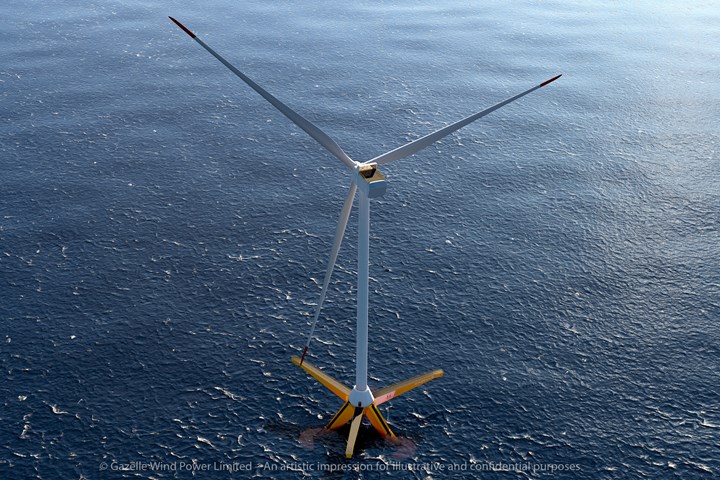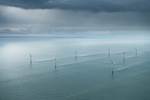Maersk Supply Service to install Gazelle Wind Power offshore wind pilot plant in Canary Islands
Two-megawatt plant will use Gazelle’s hybrid floating wind platform, established to be robust and simple to build, deploy and maintain in deep waters.

Artistic rendering of Gazelle’s offshore wind platform. Photo Credit: Gazelle Wind Power
Gazelle Wind Power (Dublin, Ireland) has signed a memorandum of understanding (MOU) with Maersk Supply Service (Copenhagen, Denmark), a provider of global offshore marine services and integrated solutions for the energy sector, to support the development of a 2-megawatt (MW) pilot plant using Gazelle’s hybrid floating wind platform at the Oceanic Platform of the Canary Islands, a Spanish archipelago off the coast of northwestern Africa. Maersk Supply Service will provide the project’s engineering, procurement, construction and installation (EPCI), which is expected to be completed in Q2 2023.
Through Maersk’s expertise in providing EPCI services, as well as its global offshore project execution in the marine sector, this partnership is said to be the next step in bringing Gazelle’s patented hybrid floating wind platform and first-of-its-kind dynamic mooring system to the commercial market.
Having demonstrated the capabilities of its technology with a statement of feasibility by classification organization DNV (Høvik, Norway), Gazelle says its platform successfully combines the top attributes of popular floating offshore wind platform designs without their drawbacks. The Gazelle platform enables wind farms to be placed in deep waters and is much lighter than conventional platforms. It is also more compact and simpler to build, deploy and maintain than other floating platforms, which translates to a lower levelized cost of energy (LCOE).
“Green transition and decarbonization initiatives are at the heart of our strategy,” says Yvan Leyni, Floating Wind Solutions director at Maersk Supply Service. “We are committed to being at the forefront of the rapidly evolving floating wind industry and are delighted to support the Gazelle pilot project.”
Gazelle notes that the more industries and world governments commit to decarbonization and net-zero emissions goals, enabling wind farms to be placed in deeper waters as far as 400 meters will be critical to generate the required energy for a growing population without fossil fuels. According to DNV, the floating offshore wind market is projected to reach as much as 250 GW of output by 2050.
Gazelle is supported by an elite group of energy industry veterans on its board of directors, including leading global policymakers, government officials, engineers and CEOs.
Related Content
-
Materials & Processes: Composites fibers and resins
Compared to legacy materials like steel, aluminum, iron and titanium, composites are still coming of age, and only just now are being better understood by design and manufacturing engineers. However, composites’ physical properties — combined with unbeatable light weight — make them undeniably attractive.
-
Novel composite technology replaces welded joints in tubular structures
The Tree Composites TC-joint replaces traditional welding in jacket foundations for offshore wind turbine generator applications, advancing the world’s quest for fast, sustainable energy deployment.
-
Materials & Processes: Resin matrices for composites
The matrix binds the fiber reinforcement, gives the composite component its shape and determines its surface quality. A composite matrix may be a polymer, ceramic, metal or carbon. Here’s a guide to selection.










.jpg;maxWidth=300;quality=90)





